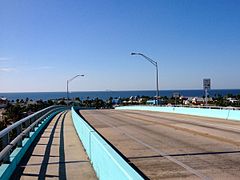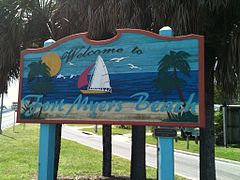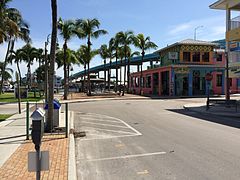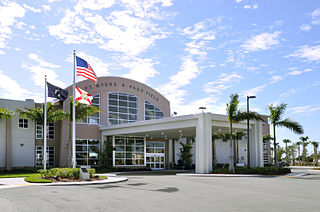
Lee County is located in southwestern Florida, United States, on the Gulf Coast. As of the 2020 census, its population was 760,822. In 2022, the population was 822,453, making it the eighth-most populous county in the state. The county seat is Fort Myers, with a population of 86,395 as of the 2020 census, and the largest city is Cape Coral, with an estimated 2020 population of 194,016.

Bonita Springs is a city in Lee County, Florida, United States. The population was 53,644 at the 2020 census. It is part of the Cape Coral-Fort Myers, Florida Metropolitan Statistical Area, on the state's southwest coast.
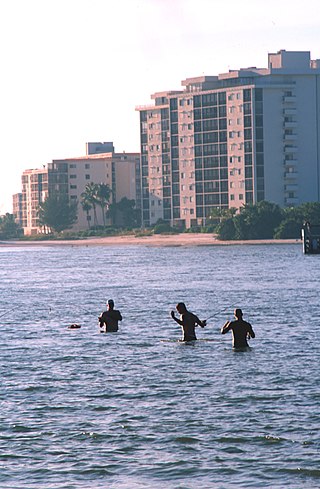
Fort Myers Beach is a town located on the North end of Estero Island in Lee County, Florida, United States. The town is on the Gulf of Mexico and is accessed from the mainland by a bridge over Estero Bay. It is part of the Cape Coral-Fort Myers, Florida Metropolitan Statistical Area. It was officially incorporated on December 31, 1995. The population was 5,582 at the 2020 census.

Sanibel is an island and city in Lee County, Florida, United States. The population was 6,382 at the 2020 census. It is part of the Cape Coral-Fort Myers, Florida Metropolitan Statistical Area. The island, also known as Sanibel Island, constitutes the entire city. It is a barrier island—a collection of sand on the leeward side of the more solid coral-rock of Pine Island.
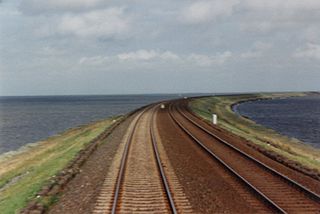
A causeway is a track, road or railway on the upper point of an embankment across "a low, or wet place, or piece of water". It can be constructed of earth, masonry, wood, or concrete. One of the earliest known wooden causeways is the Sweet Track in the Somerset Levels, England, which dates from the Neolithic age. Timber causeways may also be described as both boardwalks and bridges.

The Seminole Gulf Railway is a short line freight and passenger excursion railroad headquartered in Fort Myers, Florida, that operates two former CSX Transportation railroad lines in Southwest Florida. The company's Fort Myers Division, which was previously the southernmost segment of CSX's Fort Myers Subdivision, runs from Arcadia south to North Naples via Punta Gorda, Fort Myers, Estero, and Bonita Springs. The company's other line, the Sarasota Division, runs from Oneco south through Sarasota. Seminole Gulf acquired the lines in November 1987 and operates its own equipment. The company's first train departed Fort Myers on November 14, 1987.

The Sanibel Causeway is a causeway in Southwest Florida that spans San Carlos Bay, connecting Sanibel Island with the Florida mainland in Punta Rassa. The causeway consists of three separate two-lane bridge spans, and two-man-made causeway islands between them. The entire causeway facility is owned by Lee County and operated by the Lee County Department of Transportation. The entire causeway is 3 miles (5 km) long from end to end, and currently has a $6 toll in effect for island-bound vehicles only. The bridges are not individually named, and are simply referred to as bridges A, B, and C. The islands are also named A and B. Both series begin from the mainland side.

Area code 239 is a telephone area code in the North American Numbering Plan (NANP) for a part of Southwestern Florida. The numbering plan area (NPA) includes Lee and Collier counties, small parts of Hendry and Charlotte counties and the Everglades National Park in Mainland Monroe County. The area code was activated for service on March 11, 2002, in an area code split in which the southern half of NPA 941, from North Fort Myers, was renumbered with 239. A permissive dialing period ended on March 10, 2003.

Estero Bay, Florida, is an estuary located on the west coast of the state southeast of Fort Myers Beach. The bay, an inlet of the Gulf of Mexico, is long and very shallow and covers about 15 square miles (39 km2). Estero Bay is bordered on the west by a chain of barrier islands: Estero Island, Long Key, Lovers Key, Black Island, Big Hickory Island, and Little Hickory Island. Four outlets give access to the Gulf of Mexico: Matanzas Pass, Big Carlos Pass, New Pass, and Big Hickory Pass. Incorporated places on the bay include Estero, Bonita Springs and Fort Myers Beach. Two rivers, the Imperial River and the Estero River bring freshwater into the estuary. Tides play a major role in the functionality of the plant, crustaceans, mammals, and fish in the area. The bay is also the location of the Mound Key Archaeological State Park.

Lovers Key State Park is a 712-acre (2.88 km2) Florida State Park located on Lover's Key and three other barrier islands—Black Island, Inner and Long Key. It is at 8700 Estero Blvd., Fort Myers Beach, between Big Carlos Pass and New Pass and 10.5 miles (16.9 km) west of Interstate 75 on exit 116. The park lies within the city limits of Bonita Springs and is just north of Bonita Beach. The park uses a Fort Myers Beach zip code for address purposes.
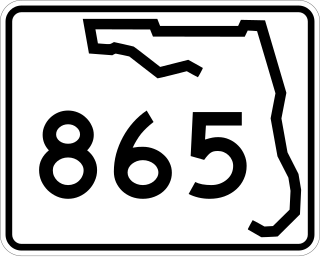
State Road 865 and County Road 865 are a series of roads serving Lee County, Florida. Originally a continuous state road extending from Bonita Springs to Tice by way of Fort Myers Beach and Fort Myers, SR 865 now consists of two segments connected by a part of CR 865, which also extends to the north and south of the state segments. Both the state and county controlled segments of the route combined stretch a distance of over 40 miles (64.37 km), making it the longest designation in Lee County.

State Road 867 and County Road 867 together create a 14.6-mile (23.5 km) long road known as McGregor Boulevard in Lee County, Florida, paralleling the Caloosahatchee River between Punta Rassa and Fort Myers. The entire road was formerly state-maintained.

The Bonita Beach Causeway is a series of four low-level bridges located in Southwest Florida traversing the barrier islands of Estero Bay connecting the town of Fort Myers Beach with Bonita Springs. It carries Estero Boulevard and is four miles (6.4 km) long from end to end. Each bridge on the Bonita Beach Causeway is named after the body of water it crosses.

The Matlacha Pass Bridge is a small single-leaf drawbridge located in Matlacha, Florida. It carries County Road 78 over Matlacha Pass, connecting Pine Island with the mainland in Cape Coral.

Estero Island is an island located in Lee County, Florida, on the Gulf coast of Southwest Florida. It is bordered by San Carlos Island to the north and Big Carlos Pass to the south. The Matanzas Pass Bridge is on the northern end of the island and connects Estero Island over Matanzas Pass to San Carlos Island. The Big Carlos Bridge connects the southern end of the island to Black Island.
Matanzas Pass Preserve is a 60-acre (24 ha) area of protected land in Lee County, Florida, located one mile south of Matanzas Pass Bridge off Estero Boulevard on Estero Island in Fort Myers Beach. The preserve has trails and a paddle craft landing. It is along the Great Calusa Blueway Paddling Trail.

The Boca Grande Causeway is a causeway located in Charlotte County, Florida, connecting the community of Boca Grande on Gasparilla Island with the mainland near Placida. The 2.5-mile (4.0 km) causeway crosses Gasparilla Sound and consists of three bridges, and is the only vehicular access to the island.
The Charlotte Harbor and Northern Railway is a historic railroad line that at its greatest extent serviced Gasparilla Island in Charlotte Harbor and a major shipping port that once operated there. The railroad's principal purpose was to transport phosphate mined along the Peace River and in the Bone Valley region of Central Florida to the port to be shipped. It also brought passengers to the island community of Boca Grande on Gasparilla Island, and is largely responsible for making Boca Grande the popular tourist destination it is today. Part of the line remains in service today between Mulberry and Arcadia, which is now owned and operated by CSX Transportation. Today, it makes up CSX's Achan Subdivision and part of their Brewster Subdivision.





